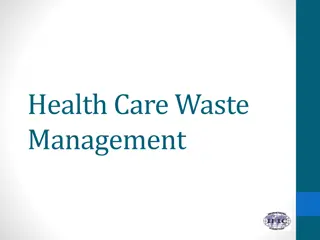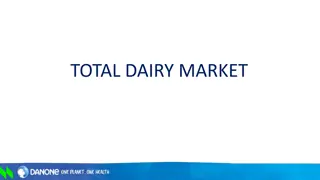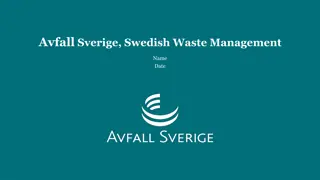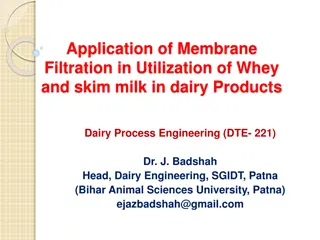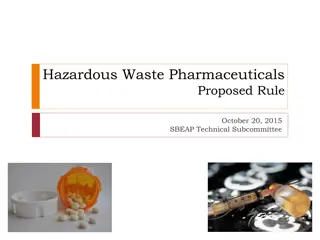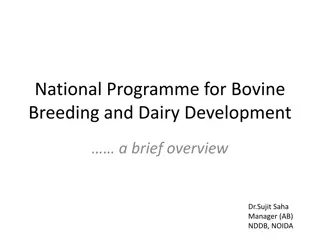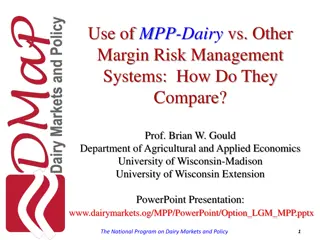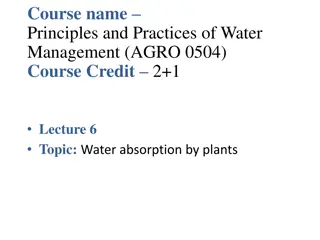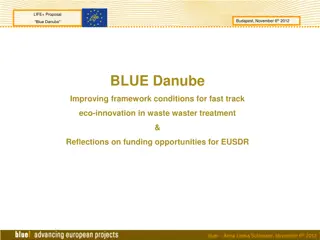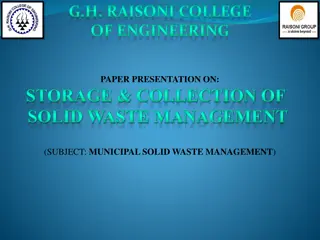Waste Water Treatment Options for Dairy Processing Plants
Factors influencing waste water treatment options for a dairy processing plant include volume and flow rates, chemical characteristics, biodegradability, controlling levels of suspended solids, BOD, and COD in discharged water. Dairy wastes have high BOD due to lactose, fats, proteins, nitrogen, and phosphorus. Different dairy plant wastes have varying chemical characteristics. Treatment options include municipal facilities, waste disposal contractors, and on-site aerobic or aerobic/anaerobic treatments.
Download Presentation

Please find below an Image/Link to download the presentation.
The content on the website is provided AS IS for your information and personal use only. It may not be sold, licensed, or shared on other websites without obtaining consent from the author. Download presentation by click this link. If you encounter any issues during the download, it is possible that the publisher has removed the file from their server.
E N D
Presentation Transcript
Waste water Treatment Options & Aerobic methods for a Dairy Processing Plant Dr. J. Badshah University Professor cum - Chief Scientist Dairy Engineering Department Sanjay Gandhi Institute of Dairy Science & Technology, Jagdeopath, Patna (Bihar Animal Sciences University, Patna)
Factors Affecting Options of Waste water Treatment Volume and flow rates of waste water depending on factory size and throughput Chemical characteristics, pH and suspended solids depending on the cleaning strategy Biodegradability of wastes treatments Control of allowable levels of SS, BOD and COD of discharged waste water Meeting the required demand of treatments in the long term period Reducing the cost of treatment and long term discharge of treated wastes facilitating biological
Characteristics of Dairy wastes Milk has BOD contents of 250 times greater than sewage. Main contributors of high BOD are lactose, fats, proteins and corresponding levels of nitrogen and phosphorus The COD and BOD for whey have, for instance, been established to be between 35,000 68,000 mg/L respectively, with lactose being responsible for 90% of the COD and BOD contribution and 30,000 60,000 mg/L,
Chemical Charateristics of Different Dairy Plant wastes Industr y mg/l Mg/l g/l BOD5 COD pH FOG, TS, mg/l TSS, mg/l Alkali nity, mg/l - Refere nces Milk Process ing Plant Butter /milk powder plant Cheese /whey Plant Whey waste water Raw Cheese whey - 713- 1410 7.1-8.1 - 900- 1470 360- 920 J. Britz and Corne van Schalk wyk , 2006 by Taylor and Franci s, pp- 1-28 - 1908 5.8 - 1720 - 532 377- 2214 189- 6219 5.2 - - 188- 2330 - 35,00 0 - 4.6 0.8 - - - - 68,814 - - 3190 1300 -
Options of Treatments for a dairy Processing Plant Treatment in nearby municipal treatment Plant facilities: i. Limitations of handling certain flow rates and peak loads ii. Limitation of handling Fat in dairy wastes iii. Limitation of handling discharge regulations of dairy wastes due to limited capacities of treatment facilities iv. High sewer treatment charges depending upon flow rates, BOD5, COD, Flow rates, SS and P contents etc. Employing Waste disposal contractors for removal of semisolids and wastes from the sites: i. Continuously impacted by increasing costs ii. Employing contractors for urgent removal of wastes is a limitation and problem iii. Control of BOD5, COD and SS as per regulation is stringent problem Onsite Treatments of wastes in own Waste treatment Plant of Factory: Aerobic alone or Aerobic and Anaerobic combination: i. Possible to control above limitation but sanitary discharges must be separate from organic dairy wastes ii. Generally preferable in a dairy plant
Onsite Treatment option 1. Physical Screening: To avoid downstream clogging and pumps by removing debris/particles To avoid the increase in COD concentration as a result of solid solublization Use of mechanically brushed and inclined screens of 40 mesh (0.39 mm) For large particles, the aperture size should not be more than 9.5 mm for screen and greet chamber Ratio of depth and width of approach channel should be 1 : 2 and the flow velocity of water should not be less than 0.6 m/s Cleaning of the screens and disposing screened materials at a landfill site
Onsite Treatment of Dairy Wastes..contd 2. pH Control Alkaline detergent cause pH 10-14 used for effective removal of proteinacous and lipid substances Acid cleaners and acid base sanitizers create pH ranging from 1.5 to 6. For biological treatment facility, the optimum pH range is required i.e 6.5 to 8.5, and therefore some forms of pretreatment for pH adjustment is necessary. If pH correction needs to be carried out in the balancing tank, the most commonly used chemicals are H2SO4, HNO3, NaOH, CO2, or lime
Onsite Treatment of Dairy Wastes..contd. 3. Flow and Composition balancing: i. To keep effluents in equalization/balancing tank for 6- 12 hr for pH adjustment and flow balancing i. Mechanical aerators can be used as a mixer for enhancing reaction of residual oxidants with solid particle to prevent solids from settling i. Size of the balance tank to handle daily flow pattern in the peak season plus few hours extra capacity to handle unforeseen increase in wastes flow
Onsite Treatment of Dairy Wastes 4. Fats, oil and grease Removals (FOG Removals): It is necessary to remove FOG completely before biological treatments. It is generally accepted that flow balancing should precede FOG removal. Gravity Traps: In this extremely effective, self-operating, and easily constructed system, wastewater flows through a series of cells, and the FOG mass, which usually floats on top, is removed by retention within the cells. Air Flotation and Dissolved Air Flotation: Mechanical removal of FOG with dissolved air flotation (DAF) involves aerating a fraction of recycled wastewater at a pressure of about 400 600 kPa in a pressure chamber, then introducing it into a flotation tank containing untreated dairy processing wastewater. The dissolved air is converted to minute air bubbles under the normal atmospheric pressure in the tank. Heavy solids form sediment while the air bubbles attach to the fat particles alongwith the remaining suspended matter as they are passed through the effluent. The resulting scum is removed and will become odorous if stored in an open tank.
Air Floatation method for FOG Removal Air flotation is a more economical variation of DAF. Air bubbles are introduced directly into the flotation tank containing the untreated wastewater, by means of a cavitation aerator coupled to a revolving impeller. A variety of different patented air flotation systems are available on the market and have been reviewed by the IDF. These include the Hydrofloat, the Robosep, vacuum flotation, electroflotation, systems. and the Zeda
Pretreatment before DAF/AF method for FOG Removal The main drawback of the DAF, is that only SS and free FOG can be removed. Thus, to increase the separation efficiency of the process, dissolved material and emulsified FOG solutions must undergo a physico-chemical treatment during which free water is removed and waste molecules are coagulated to form larger, easily removable masses. This is achieved by recirculating wastewater prior to DAF treatment in the presence of different chemical solutions such as ferric chloride, polyelectrolytes that can coagulants. pH correction might also be necessary prior to the flotation treatment, because a pH of around 6.5 is required for efficient FOG removal aluminum act as sulfate, and and coalescents
Onsite Treatment of Dairy Wastes: Treatment Methods 1. Biological Treatment: Biological degradation is one of the most promising options for the removal of organic material from dairy wastewaters. Aerobic Biological Systems: Aerobic biological treatment methods depend on microorganisms grown in an oxygen-rich environment to oxidize organics to carbon dioxide, water, and cellular material. It is a reliable and cost-effective method in producing a high-quality effluent. Start-up usually requires an acclimation period to allow the development of a competitive microbial community. With wide variations in waste water flow, strength, temperature, and pH, some reaction time is required to allow neutralization of acid and alkaline cleaning compounds and to allow for complete reaction of residual oxidants from cleaning solutions with organic solids of dairy waste. Ideally, a minimum of 6 12 hours of equalization should be provided to allow for waste stabilization. Ammonia-nitrogen can successfully be removed, in order to prevent disposal problems. Problems normally associated with aerobic processes include foaming and poor solid liquid separation. i. a. b.
Ponds for Aerobic Treatments A pond or lagoon normally consists of a shallow basin designed for treatment of dairy waste water without extensive equipment and controls. The three types of ponds used are aerobic, facultative, and anaerobic. 1. Aerobic ponds Aerobic ponds are generally 0.5 2.0 meters deep, and contents are mechanically mixed and aerated to allow penetration of sunlight necessary for growth of algae. The algae produce oxygen through photosynthesis and use waste products from the bacteria involved in the biological breakdown of milk wastes. At 20 C, a BOD removal of 85% can be experienced with an aeration period of 5 days. 2. Anaerobic ponds Anaerobic ponds are generally used to pre-treat dairy wastes with high protein and fat levels or for stabilizing settled solids. Organic matter is biodegraded and gases such as CH4, CO2, and H2S are produced. To reduce effectively the BOD in anaerobic effluent, an aerobic process must follow to allow aerobic microorganisms to use up the residual breakdown products. The typical retention time for anaerobic treatment ponds ranges from 20 to 50 days.
The conventional activated sludge process (ASP) It is defined as a continuous treatment that uses a consortium of microbes suspended in the wastewater in an aeration tank to absorb, completely oxidized to harmless end products and other inorganic substances to provide energy to sustain the microbial growth and the formation of biomass (flocs). The flocs are kept in suspension either by air blown into the bottom of the tank (diffused air system) or by mechanical aeration. The dissolved oxygen level in the aeration tank is critical and should preferably be 1 2 mg/L and the tank must always be designed in terms of the aeration period and cell residence time. The mixture flows from the aeration tank to a sedimentation tank where the activated sludge flocs form larger particles that settle as sludge. Activated sludge contains a large mass of various microorganisms plus organic and inorganic particles. The concentration of biomass in the aeration or contact tank is normally called the mixed liquor suspended solids (MLSS). Bacteria make up the largest portion of activated sludge in the aeration process. Bacteria are primarily responsible for oxidation of organic matter and formation of polysaccharides and other polymeric materials that aid in flocculation of the microbial biomass
Aerobic Filters Aerobic filters such as conventional trickling or percolating filters are among the oldest biological treatment methods for producing high- quality final effluents. The carrier media (20 100 mm diameter) may consist of pumice, rock, gravel, or plastic pieces, which is populated by a very diverse microbial consortium. Wastewater from a storage tank is normally dosed over the medium and then trickles downward through a 2-m medium bed. The slimy microbial mass growing on the carrier medium absorbs the organic constituents of the wastewater and decomposes them aerobically. Sludge deposits require removal from time to time. Aerobic conditions are facilitated by the downward flow and natural convection currents resulting from temperature differences between the air and the added wastewater.
Aerobic Filterscontd. The two most important factors affecting microbial growth on the support medium are flow rate of wastewater and size and geometrical configuration of support material. In the initial start-up of the filter, the medium surface is colonized by gram- negative bacteria followed by filamentous bacteria. The biofilm formed on support material is called a zoogleal film and is composed of bacteria, fungi, algae, protozoa, and other life forms such as rotifers, nematodes, snails, and insect larvae. Some of the bacterial genera active in trickling filters are Achromobacter, Flavobacterium, Pseudomonas and filamentous bacteria such as Sphaerotilus. Growth conditions on the outer surface of the biofilm are aerobic but the inner portion of the biofilm next to support material tends to be anaerobic. Trickling filters are categorized by the loading rate to the filter medium. Low- rate trickling filters (40 kg BOD/ 100 m3/ day) allow for nitrification and more complete removal of nutrients from wastewater. High-rate filters (60 160 kg BOD/ 100 m3/ day) rarely have nitrification take place and have lower treatment efficiencies. BOD removal by trickling filters is approximately 85% for low-rate filters and 65 75% for high rate filters.



